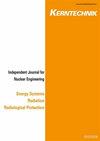利用纳米流体进行能量应用的微通道散热器的传热和压降分析
IF 0.4
4区 工程技术
Q4 NUCLEAR SCIENCE & TECHNOLOGY
引用次数: 1
摘要
摘要:本研究的目的是在电子、喷墨打印、激光高热流密度冷却等领域,利用相同长度和液压直径、不同微通道几何形状(三角形、矩形、梯形、半圆形和圆形)的直形和波浪形散热器增强传热。所采用的纳米流体是水/氧化铝(水/Al2O3),流动形式是层流。本研究的雷诺数(Re)范围为220≤Re≤550,纳米颗粒Al2O3与重水(2H2O)的浓度为1.2 %体积。本研究使用三维计算流体动力学(CFD)模拟软件研究了几种横截面微通道的传热特性。数值研究采用有限体积方法,并利用不同波浪剖面的文献对CFD分析进行了验证。根据CFD模拟结果,圆形截面的微通道在其他截面中具有最高的换热性能(高达18% %)。圆形截面微通道似乎对冷却剂温度有最显著的提高(9-22 %)。分析结果表明,圆形截面的微通道传热性能最好;在相同的几何参数和边界条件下,三角形通道的性能最低。因此,建议圆形微通道的载热能力为150 W/cm2,水力直径为500 µm,雷诺数为500。本文章由计算机程序翻译,如有差异,请以英文原文为准。
Heat transfer and pressure drop analysis of a microchannel heat sink using nanofluids for energy applications
Abstract The present research aims to enhance heat transfer in straight and wavy profile heat sinks using the same length and hydraulic diameter with different microchannel geometries (triangular, rectangular, trapezoidal, semi-circular, and circular) for uses in electronics, inkjet printing, high heat flux cooling of lasers, and other domains. The nanofluid employed is water/aluminum oxide (water/Al2O3), and the flow regime is laminar. The range of Reynolds number (Re) in this study was 220 ≤ Re ≤ 550, and the concentrations of nanoparticle Al2O3 with Heavy Water (2H2O) were 1.2 % volume. This investigation uses 3-dimensional Computational Fluid Dynamics (CFD) simulation software to investigate the heat transfer characteristics of several cross-sectioned microchannels. The numerical investigation utilizes the finite volume approach, and the CFD analysis is validated with accessible literature with different wavy profiles. According to the CFD simulation results, the microchannel with a circular cross-section has the highest heat transfer performance (up to 18 %) among the other cross-sections. The circular cross-section microchannel seemed to have the most significant increase in coolant temperature (by 9–22 %). The analysis outcomes prove that the microchannel with a circular cross-section has the highest performance for heat transfer; the triangular channel has the lowest performance under the same geometric parameters and boundary conditions. So, it is suggested that a circular microchannel can be used for a heat-carrying capacity of 150 W/cm2, a hydraulic diameter of 500 µm, and a Reynolds number equal to 500.
求助全文
通过发布文献求助,成功后即可免费获取论文全文。
去求助
来源期刊

Kerntechnik
工程技术-核科学技术
CiteScore
0.90
自引率
20.00%
发文量
72
审稿时长
6-12 weeks
期刊介绍:
Kerntechnik is an independent journal for nuclear engineering (including design, operation, safety and economics of nuclear power stations, research reactors and simulators), energy systems, radiation (ionizing radiation in industry, medicine and research) and radiological protection (biological effects of ionizing radiation, the system of protection for occupational, medical and public exposures, the assessment of doses, operational protection and safety programs, management of radioactive wastes, decommissioning and regulatory requirements).
 求助内容:
求助内容: 应助结果提醒方式:
应助结果提醒方式:


